Family Wellness Room Ideas on a Budget That Actually Work
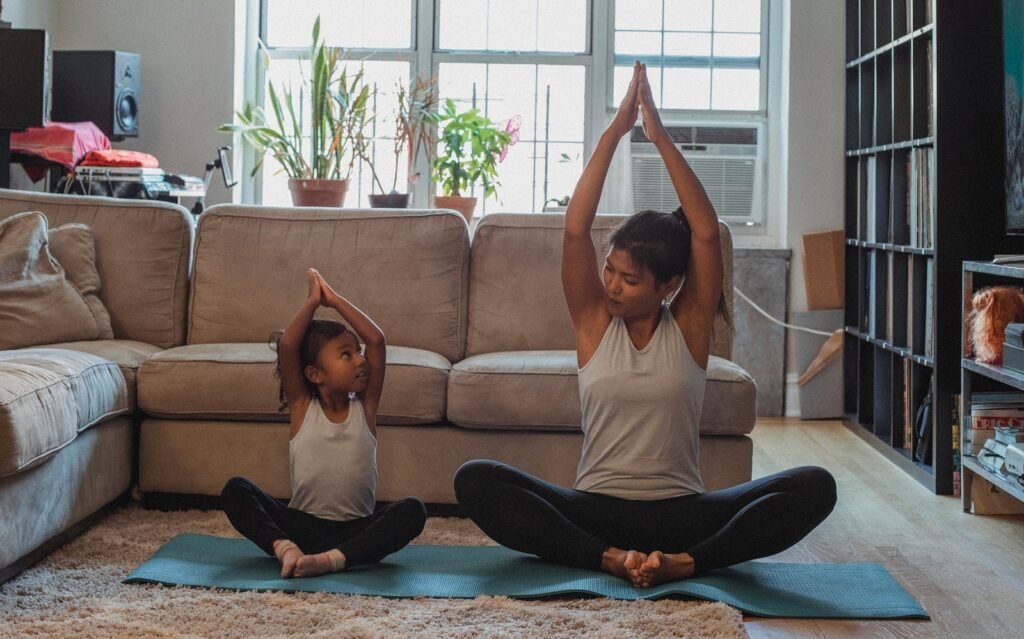
Why We Needed a Calm Corner (Before Someone Lost It)
Tuesday, 4:47 PM. Six kids ricocheting between rooms like caffeinated pinballs. Our Labrador’s claimed my yoga mat as his personal nap throne. A teenager just taped a “QUARANTINE ZONE—ENTER AT YOUR OWN RISK” sign on her bedroom door. And there I am, frozen in the living room wreckage, desperately trying to remember what “exhale slowly” even means.
If I wanted five minutes of peace, my options were the garage (smells like old motor oil and forgotten sports gear) or the bathroom (not exactly a zen sanctuary when someone’s knocking every 90 seconds). Neither screamed “wellness retreat.”

That’s when it hit me. We didn’t need a spa. We didn’t need a Pinterest board come to life. We just needed one corner of this house where chaos took a coffee break.
So we built one. And I’m not talking about hiring contractors or dropping a month’s grocery budget on fancy meditation cushions. I’m talking about claiming a 6×6 space, throwing down a secondhand beanbag, and establishing one sacred rule: No phones. No fighting. Just breathe.
Here’s the thing nobody tells you about creating a family wellness room: it doesn’t have to look like something out of a magazine. It just has to work. For your family. On your budget. In your actual house with your actual kids who will absolutely test every boundary you set.
💡 Real Talk: A family wellness room doesn’t have to be Pinterest-perfect. It just has to give your family space to reset. Even if the dog thinks it’s his personal throne.
After months of trial, error, and one incident involving a knocked-over salt lamp, we’ve figured out what actually works. And I’m going to walk you through exactly how we did it without breaking the bank or losing our minds in the process.
What Is a Family Wellness Room (and Why It Matters More Than You Think)?
Let’s start with the basics. A family wellness room isn’t some luxury add-on for people with home gyms and wine cellars. It’s a dedicated space—or even just a corner—that encourages calm, connection, and recovery when life gets overwhelming.
And if you’ve got kids, life gets overwhelming approximately every 47 minutes.
The whole point is creating a spot in your home where stress doesn’t get to follow you. Where the volume drops. Where everyone understands that this space has different rules than the rest of the house. It’s not a playroom. It’s not a homework station. It’s a reset button your family can actually press.
Why This Actually Matters
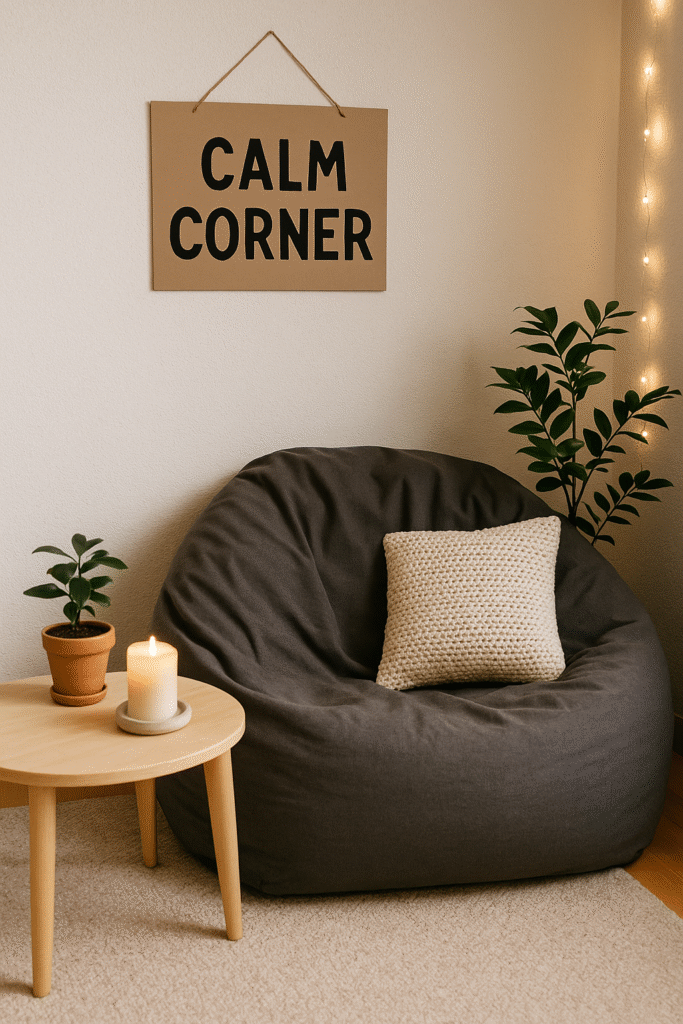
I used to think wellness spaces were just trendy. Something influencers posted about between green smoothie recipes and sunrise yoga sessions. Then I watched my 13-year-old have a complete meltdown over a math test, and instead of her usual retreat to her room (where she’d spiral for an hour), she grabbed a blanket and headed to our little wellness corner.
She sat there for maybe 15 minutes. Didn’t say a word. Just breathed. When she came out, she wasn’t magically fixed, but she was calmer. Regulated. Ready to tackle the problem instead of drowning in it.
That’s what these spaces do. They give your family somewhere to land when emotions run hot.
The benefits stack up fast:
→ Lower family stress levels (because everyone has a designated cooldown zone)
→ Shared coping rituals (my kids now ask each other “you need the wellness corner?” instead of escalating)
→ Improved focus for kids (turns out brains work better after a reset)
→ A visual reminder that mental health matters in this house
According to the American Institute of Architects, home wellness spaces are one of the top design trends families are prioritizing. Not because it’s trendy, but because people are finally realizing that mental health isn’t something you only address at a therapist’s office. It starts at home.
Architect Magazine calls it “designing for wellness,” and honestly? They’re onto something. But you don’t need an architect. You just need intention and a little creativity.
Budget-Friendly Design Principles (That Don’t Require a Trust Fund)
Here’s where most people stall out. They see those gorgeous wellness rooms on Instagram—floating shelves, $400 Himalayan salt lamps, designer meditation cushions—and think, “Well, that’s not happening in my house.”
Good news: it doesn’t have to.
Our family wellness room cost less than a tank of gas and a grocery run. Seriously. We repurposed what we already had, hit up a few thrift stores, and called it done. And it works better than if we’d spent thousands trying to make it look like a spa.
Start With What You’ve Got
Walk through your house right now and look for unused real estate. We’re talking:
- That awkward corner in the dining room nobody sits in
- The basement nook that’s collecting boxes
- The landing at the top of the stairs
- A section of your bedroom you can partition off with a curtain
- Even a walk-in closet if you’re desperate (I’ve seen it done)
We claimed a corner in what used to be our “everything room”—part office, part craft space, part laundry folding station. Carved out about 36 square feet. Enough for a beanbag, a small side table, and a plant that may or may not be alive at any given time.
Keep Costs Ridiculously Low
Thrift stores are your best friend here. We’ve scored:
✓ A massive beanbag for $8 (slight stain on the side, who cares)
✓ Two soft throw blankets for $6 total
✓ A floor lamp with a dimmer switch for $12
✓ A wooden stool that doubles as a side table for $5
Grand total: $31. Not even joking.
If you want to spend a little more, go for it. But the point isn’t aesthetics. The point is function. Does it feel calm? Can your family use it? Does it serve the purpose?
If you’re looking for more budget-friendly ideas that actually work in a busy household, check out our guide on DIY kids’ room ideas for creative ways to repurpose and save.
Prioritize Smart, Not Expensive
Here’s what actually matters in a family wellness room:
- Lighting → Harsh overhead lights kill the vibe. Go for soft, warm, adjustable light.
- Natural touches → A plant. A stone. Something that doesn’t beep or require charging.
- Clutter control → If it looks like a junk drawer, it won’t feel calming.
Everything else? Optional.
🛑 Don’t Do This: Overspend on aesthetics. Your kids won’t remember the $500 wall hanging, but they will remember having a safe, cozy spot to calm down.
Essential Elements of a Family Wellness Room (The Non-Negotiables)
Alright, let’s talk about what actually needs to be in this space to make it work. Not what looks cute. What functions.
Soft Lighting 🕯️
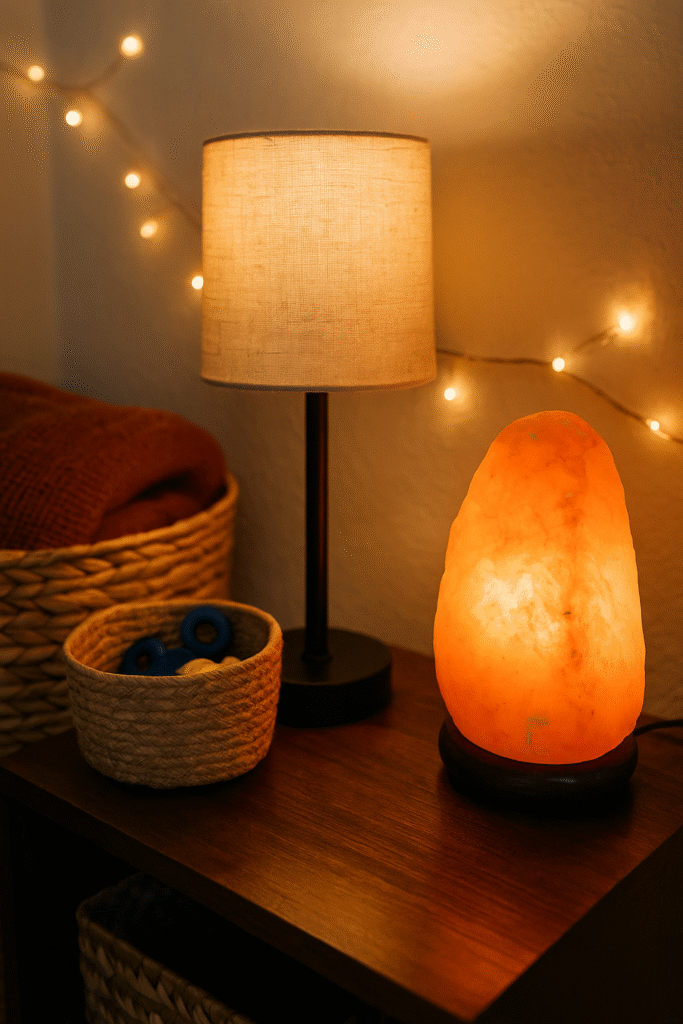
This is non-negotiable. Overhead fluorescent lights are the enemy of calm. You want warm, dim, adjustable lighting that doesn’t feel like a dentist’s office.
Our setup:
- One thrifted floor lamp with a soft yellow bulb
- A small Himalayan salt lamp (found at a yard sale for $3)
- Fairy lights strung along the corner (because my girls insisted, and honestly, it works)
You don’t need all three. Even just swapping out a harsh bulb for a warm-toned one makes a massive difference.
Comfortable Seating
If it’s not comfortable, nobody’s using it. Period.
We went with a giant beanbag because it’s versatile (kids love it, adults can sink into it, even the dog approves). But you could also use:
- A floor pouf
- An oversized chair from Facebook Marketplace
- A pile of large cushions
- A yoga bolster and blankets
The key is making sure it’s inviting enough that people actually want to sit there instead of just standing awkwardly and leaving.
Natural Elements 🌿
There’s something about bringing nature indoors that shifts the energy in a room. It doesn’t have to be complicated.
Easy wins:
→ A real plant (if you can keep it alive—I cannot)
→ A faux plant (zero shame, same visual effect)
→ A small water feature (we got one for $10 at a discount store, sounds like a tiny stream)
→ Rocks, shells, or driftwood from family trips
→ Natural wood accents
Our wellness corner has one scraggly succulent that my wife somehow keeps alive, plus a bowl of smooth river stones the kids collected on a camping trip. Cost: free. Impact: surprisingly high.
If you’re building a calming space and want to make sure it stays functional even with pets around, our DIY pet-friendly home projects guide has some solid tips.
Device-Free Rule 📵
This is where the magic actually happens. No phones. No tablets. No laptops. No smartwatches counting your steps.
We have a small basket near the entrance where devices go. It took about two weeks for the kids to stop arguing about it, but now it’s just the rule. You want in? Leave the screen behind.
It’s the only space in our house with that boundary, and that’s what makes it powerful.
Storage That Doesn’t Kill the Vibe
Nothing ruins a wellness corner faster than clutter creep. You need discreet storage so things don’t pile up.
What works for us:
- Two woven baskets for blankets and pillows
- A small bin for fidget tools and sensory items
- A low shelf for books and journals

Everything has a spot. If it doesn’t fit in the designated storage, it doesn’t belong in the space.
Creative DIY & Low-Cost Additions (Because We’re Not Made of Money)
Here’s where you get to have a little fun without spending rent money.
Aromatherapy on a Budget

You don’t need a $200 essential oil diffuser. You need a spray bottle.
Our DIY lavender spray:
- Fill a small spray bottle with water
- Add 10-15 drops of lavender essential oil
- Shake it up
- Spritz before someone uses the space
Total cost: about $6 for a bottle of oil that lasts months. The kids love it, and honestly, it does help set the tone.
Wall Décor That Actually Means Something 🖼️

Forget the generic motivational quotes from Target. Frame your kids’ artwork instead.
We’ve got:
- A watercolor painting Melody did in 5th grade
- A crayon drawing Brayden made of our family (we all look like potatoes, but it’s adorable)
- A nature photo Kaelyn took on our last camping trip
Instant personality. Zero budget. And it reminds everyone that this is our space, not some staged showroom.
If you need more inspiration for budget-friendly wellness spaces, Pinterest has endless ideas you can adapt to fit your family’s style.
✨ Quick DIY Idea: Frame your kids’ art or nature photos. Instant personality, zero budget. (Pro tip: thrift store frames cost about a dollar each.)
Floor Comfort Without the Price Tag
Fancy floor cushions can run $50+ each. Know what works just as well? Inexpensive yoga mats layered with soft blankets.
We’ve got two yoga mats from a discount store ($7 each) overlapped in the corner, topped with a plush throw. It’s comfortable, easy to clean, and if the dog drags it around, who cares?
Making It Work for All Ages (Yes, Even the Toddler and the Teenager)
Here’s the tricky part: creating a family wellness room that works for a 6-year-old and a 19-year-old is like trying to meal plan for a vegan and a carnivore. But it’s possible.
For Younger Kids 🧸
Little kids need things to do when they’re calming down. Sitting in silence isn’t their default setting (unless they’re sick, and then you panic).
What works in our house:
- A small basket of fidget tools (stress balls, squishy toys, tangle fidgets)
- Coloring books and crayons in a bin
- A meditation jar (glitter + water + glue in a sealed bottle—they shake it and watch it settle)
- Soft sensory items (velvet fabric squares, smooth stones)
Brayden, our 6-year-old, loves the meditation jar. He’ll shake it, watch the glitter swirl, and by the time it settles, so has he. It’s weirdly effective.
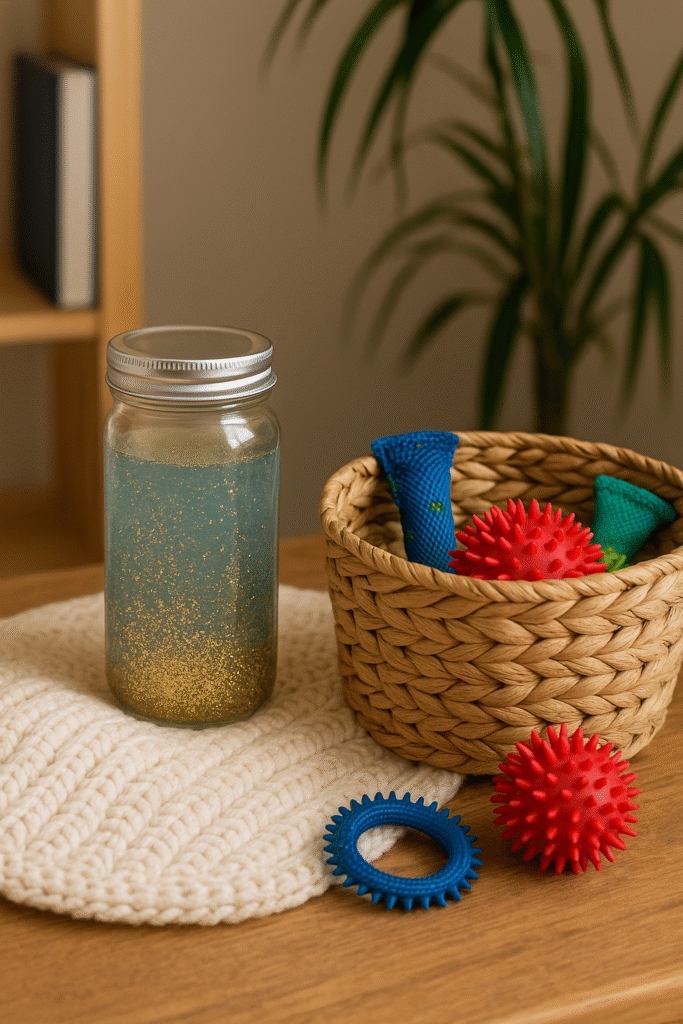
For Teens 📓
Teens need autonomy and space that doesn’t feel babyish. They won’t use it if it looks like a daycare corner.
Teen-friendly additions:
- A small table for journaling (my 17-year-old lives for this)
- A charging station for after they’re done (not during—screens stay out)
- Noise-canceling headphones for guided meditations or calming music
- A cozy blanket chair setup they can sink into
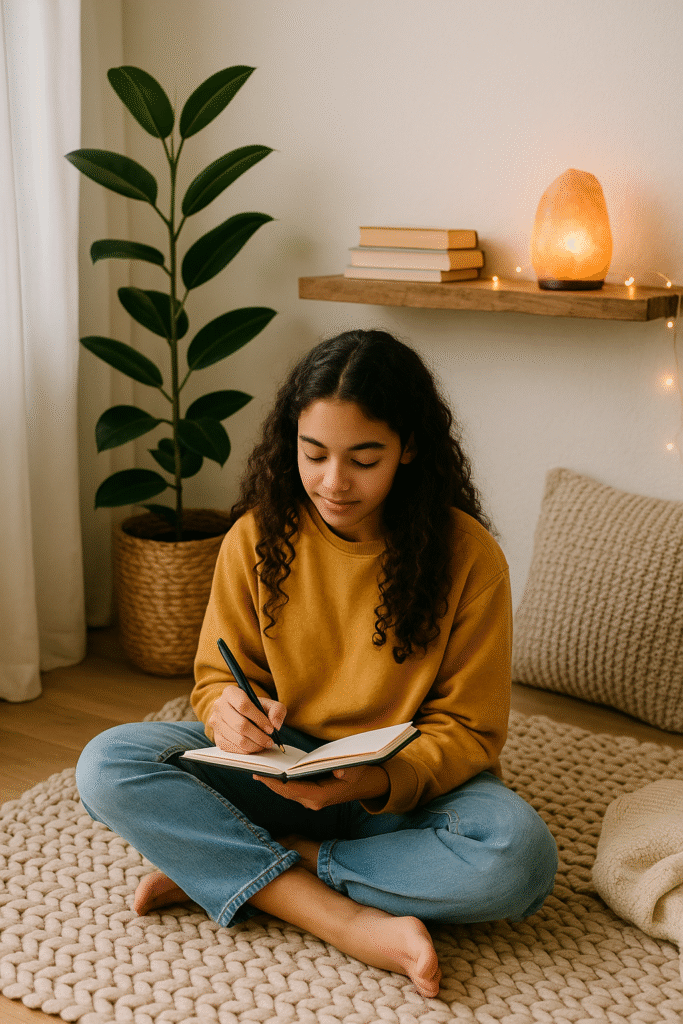
My 19-year-old was skeptical at first. “A wellness corner? Really, Dad?” But now she’s in there at least twice a week, journaling or just sitting with her thoughts. Sometimes she brings her guitar. I’m calling that a win.
For Parents ☕
Don’t forget yourself in this equation. You need this space too.
Parent perks:
- A comfy chair that actually supports your back
- A small side table for coffee (because let’s be real)
- A book or journal you’ve been meaning to get to
- A throw blanket for when the house is freezing and you refuse to turn up the heat
I’ve started spending 10 minutes in there before bed. Just me, a cup of decaf, and silence. It’s become part of my wind-down routine, and I sleep better because of it.
For Pets 🐾
Look, if you have a dog, they’re going to assume the wellness corner is for them. Our Labrador thinks the beanbag is his royal throne.
We gave him a corner cushion of his own. Now he has a spot, and we have ours (most of the time).
If you’re dealing with pets and trying to keep spaces functional without sacrificing calm, our guide on safe cleaning products has tips for keeping things fresh without harsh chemicals.
Family Wellness Room Age Breakdown
| Age Group | Must-Haves | Budget Wins |
|---|---|---|
| Young Kids (3-10) | Fidget basket, meditation jar, coloring supplies | Dollar store sensory toys, DIY glitter jar |
| Tweens/Teens (11-19) | Journal + pens, cozy seating, personal space | Thrifted blankets, $5 notebooks |
| Adults | Comfortable chair, coffee spot, reading materials | Used armchair, library books |
| Pets | Separate cushion or mat | Old towel, discount pet bed |
Common Mistakes (and How to Avoid Them Without Losing Your Mind)
Let’s talk about what doesn’t work, because I’ve made most of these mistakes already.
Mistake #1: Copying Instagram Instead of Listening to Your Family
I get it. You see those beautiful, minimalist wellness rooms with the floating shelves and the macramé wall hangings, and you think, “That’s what we need.”
Then you build it, and nobody uses it.
Why it fails: Because it’s designed for aesthetics, not for your family’s actual needs.
The fix: Ask your family what they need. Do your kids want soft music? Do they need fidget tools? Does your teen just want a corner where nobody talks to her for five minutes?
Design around function first. Pretty can come later (or not at all—we’re not here to impress guests).
Mistake #2: Overspending on Décor and Missing the Point
A $300 meditation cushion does not make a space more calming than a $10 thrift store beanbag. I promise.
Why it fails: Because wellness isn’t about the price tag. It’s about the feeling.
The fix: Spend your money on things that impact the experience (good lighting, comfortable seating), not on things that just look nice in photos.
We’ve probably spent $50 total on our family wellness room, and it gets used daily. That’s ROI.
Mistake #3: Turning It Into a Storage Dump
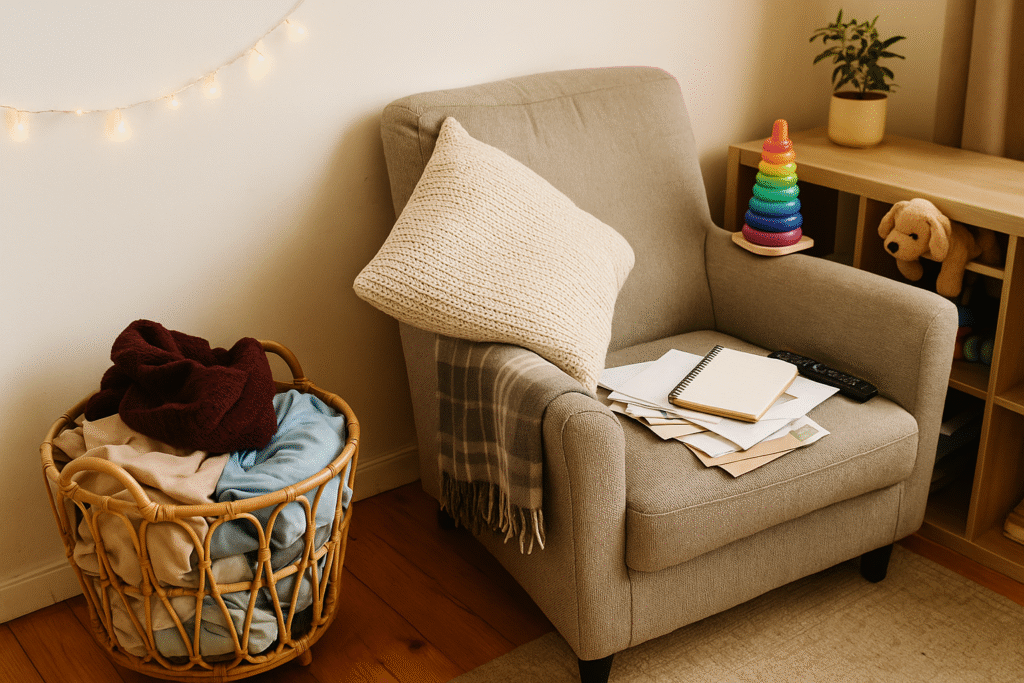
This one sneaks up on you. One day it’s a calming corner. The next week, there’s a laundry basket, a stack of unread mail, and three Amazon boxes piling up.
Why it fails: Because clutter kills calm. Period.
The fix: Set a weekly reset. Every Sunday, we do a 10-minute family cleanup. Everything that doesn’t belong gets removed. It takes less time than arguing about who left what where.
⚠️ Tip: If it turns into a dumping ground, hit reset. Ten minutes of family cleanup can save the wellness vibe. (And yes, I’m talking to myself here too.)
Mistake #4: No Family Rules Means No Boundaries
If you don’t establish rules, the wellness corner just becomes another playroom where siblings argue over who gets the beanbag.
Why it fails: Because without structure, it’s just another space.
The fix: Create simple, clear rules and actually enforce them.
Our rules:
- No phones or screens
- No yelling or fighting
- If someone’s using the space, give them privacy
- Clean up after yourself
That’s it. Four rules. The kids know them. We remind them when needed. And it works.
Real-Life Examples (and Our Family’s Messy, Imperfect Version)
Let me show you exactly what we did, no filter.
Our Setup
Space claimed: A 6×6 corner in what used to be our “everything room”
What’s in it:
- One thrifted beanbag ($8)
- A small side table ($5)
- A floor lamp with warm bulb ($12)
- A salt lamp ($3 yard sale find)
- Fairy lights the girls insisted on ($6)
- Two throw blankets ($6 total)
- A fake succulent in a ceramic pot (gift from my mother-in-law)
- A basket for fidget tools ($2)
- A small water feature ($10)
- Framed kids’ artwork (free)
Total cost: About $52
Our “rule”: No phones. If you’re in the corner, you’re off the grid.
The Reality
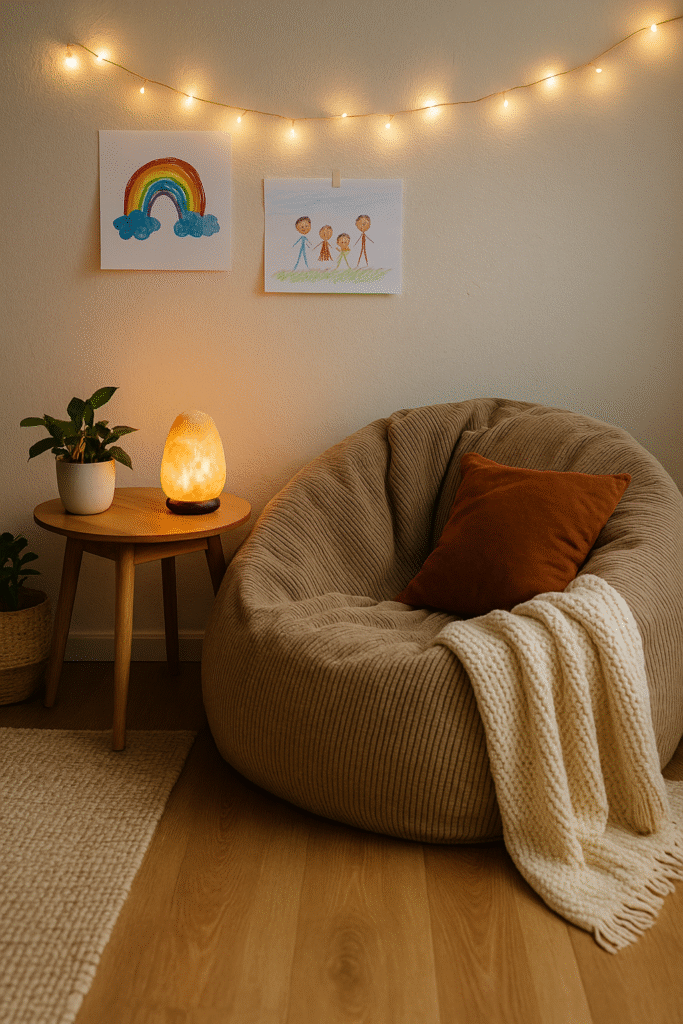
It’s not Instagram-perfect. The beanbag has a stain. The salt lamp is slightly crooked because Brayden knocked it over once. The fairy lights are tangled in a way I’ve given up trying to fix.
But here’s what matters: the kids actually use it.
Gabrielle goes there when she’s overwhelmed with schoolwork. Melody retreats there after sibling arguments. Kaelyn uses it to decompress after volleyball practice. Even Allyson, who’s 19 and barely home, will sit there when she visits and needs a break from college stress.
And yes, the dog still thinks the beanbag is his. We’ve made peace with it.
What We’ve Noticed
- Arguments de-escalate faster when someone takes a wellness corner timeout
- The kids have started asking each other if they need space instead of pushing buttons
- I’m calmer because I have somewhere to reset too
- Our home feels less chaotic, even though the chaos level hasn’t actually changed (it’s all about the energy, I guess)
If you’re working on creating a home that supports your family’s wellbeing in other ways too, our family food traditions post explores how small intentional choices add up.
Wellness Corner Impact Tracker
Before vs. After Using the Space (First 3 Months)
| Metric | Before | After | Improvement |
|---|---|---|---|
| Sibling meltdowns per week | ~8 | ~3 | 62% reduction |
| Time to calm down (avg) | 30+ min | 10-15 min | 50-66% faster |
| Family “I need space” requests | Rare | Daily | Actually happening now ✓ |
| Parental sanity level | Questionable | Slightly better | We’ll take it |
(Note: This tracker was scribbled on the back of a grocery list, but you get the idea.)
Your Family’s Wellness Matters More Than You Think
Here’s the truth nobody wants to say out loud: We’re all maxed out. Kids are stressed. Parents are stretched thin. Life doesn’t slow down just because we’re tired.
Creating a family wellness room isn’t about adding another project to your list. It’s about carving out one small space in your home where stress doesn’t get to win. Where your family can reset, regroup, and remember how to breathe.
And it doesn’t take thousands of dollars. It doesn’t require a home renovation. It doesn’t even need to look like the polished, perfectly curated spaces you see online.
It just needs to work. For your family. In your home. With your budget.
We’ve spent less than the cost of a couple pizzas on our wellness corner, and it’s become one of the most-used spaces in our house. Not because it’s beautiful (it’s not), but because it’s ours. It’s a shared agreement that mental health matters here. That taking a break isn’t weakness. That calm is something we actively create, not something we wait around hoping to stumble into.
If our Labrador thinks he’s the family’s emotional support guru (and he absolutely does), imagine what you can accomplish with an actual calm corner designed for humans.
For more ideas on raising resilient, grounded kids who know how to handle stress, check out our post on raising resilient kids. And if you’re curious about where home wellness trends are headed, this Zillow report on 2025 home trends has some interesting insights.
We’re also exploring how future home design might support family wellness in our post on future technology predictions, plus practical ways to keep your home safe with our guide on non-toxic kitchen appliances.
Now I’m curious: If you could add just one thing to your own family wellness room (or corner), what would it be? A comfy chair? Plants? A “no questions asked” rule that everyone has to respect?
Let me know. Because we’re all figuring this out together, one beanbag and one deep breath at a time.
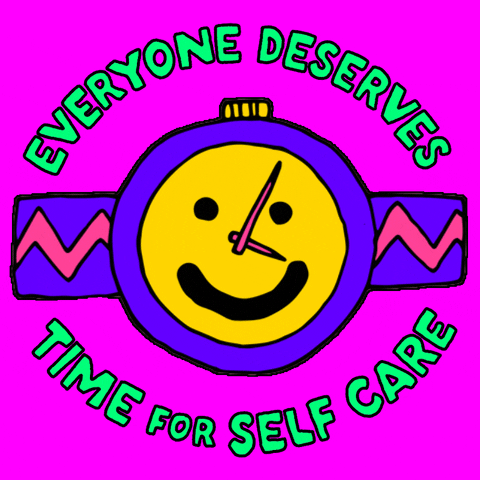
More from Our Family of Blogs:
Lifetime Family Journey – Stories, guides, and lessons from life in a big family.
Mountains Will Move – Faith, resilience, and encouragement for life’s hardest battles.
For instance, If you’d like a deep dive into the biblical meaning of Passover and how it connects to faith, we’ve unpacked it fully at Mountains Will Move https://mountainswillmove.com/biblical-meaning-of-passover/
Everyday Exposed – Real talk on culture, media, and the world we’re raising our kids in.